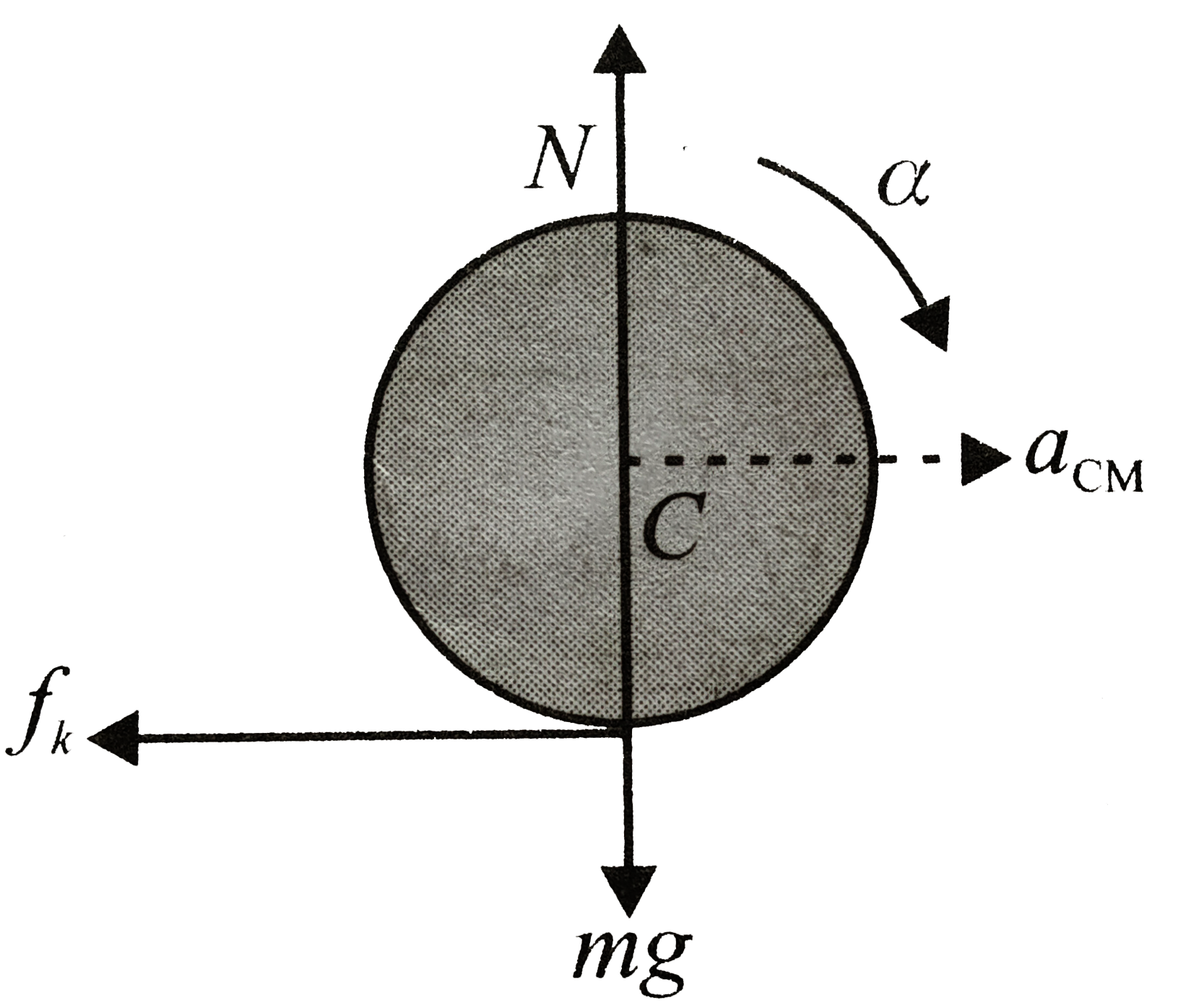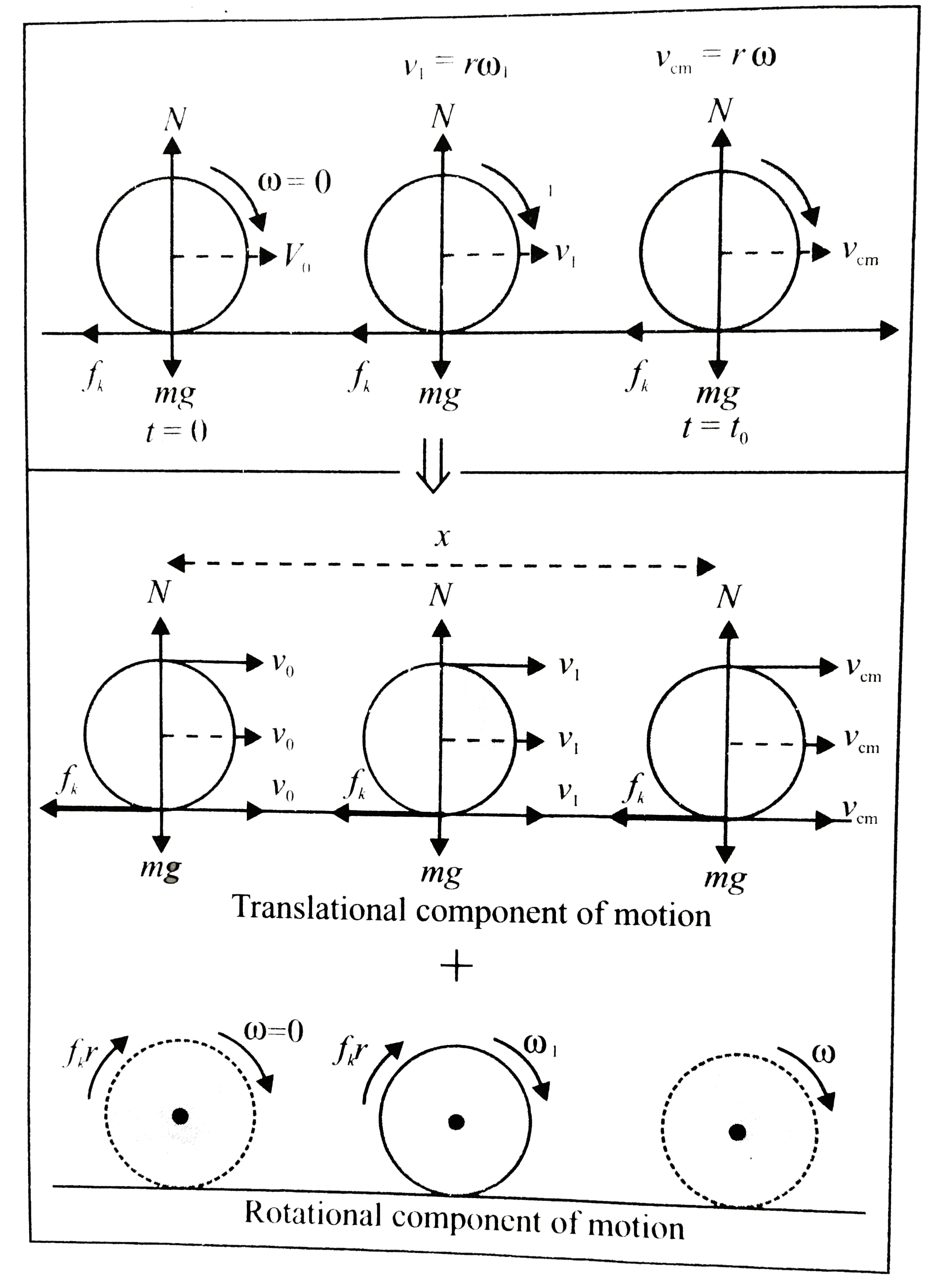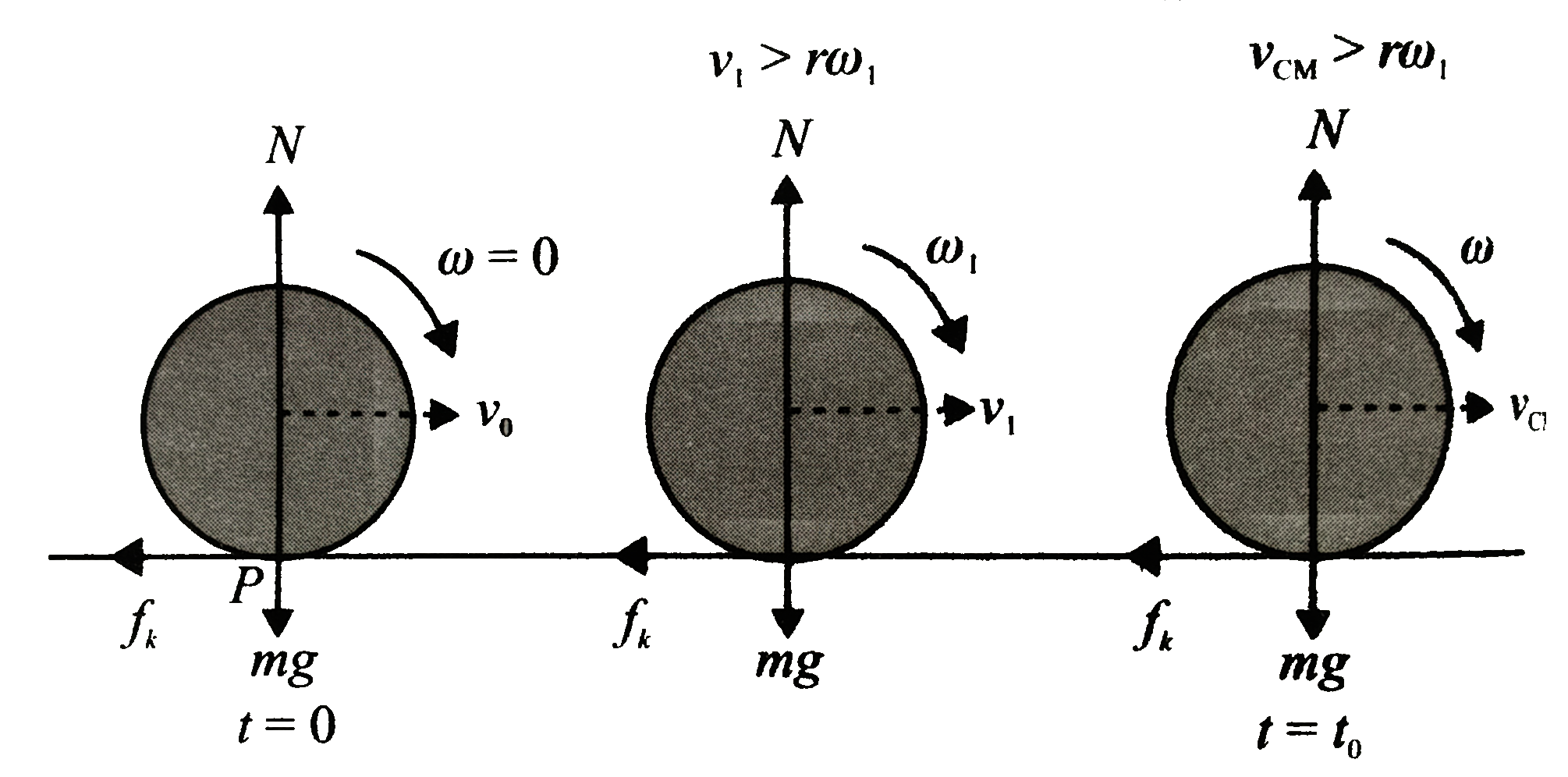A ball (solid sphere) is thrown down the valley in such a way that it slides with a speed v0 initially without rolling. Prove that it will roll without any sliding when its speed falls to (57)v0. The transition from pure sliding to pure rolling is gradual, so that both sliding and rolling take place during this interval.
Method 1: Force/Torque Method: The forces acting on the ball are as shown in Fig. Let the acceleration of the centre of mass be aCM and its angular acceleration about the centre of mass axis be α as shown in the figure.

The following filgus represent the forces, accelerations and velocities of the ball in three different positions.

Force equations: N−mg=0(in the vertical direction)
−fk=maCM ( in the horizontal direction)
⇒aCM=−fkm...........i
And from τCM=ICMα
⇒fkr(25mr2)α
⇒α⎛⎝fkr25mr2⎞⎠..........ii
Let the velocity of the centre of mass be vCM and angular velocity about the centre of mass axis be ω when rolling starts.
vCM+v0+(−fkm)t (using v=u+at)...........iii
and ω=0+⎛⎝fkr25mr2⎞⎠t(ω=ω0+at)............iv
also vCM=rω
Solving eqn iii, iv, and v for vCM, we get
vCM=57v0
Method 2: Work Energy Theorem
Apply the work energy theorem for the translation and rotational components of the motion separately.
∑Wforce=△Ktranslational
∑Wtorque=△Krotational

Mathematically Wfk+WN+Wmg=(K2−K2)translational
⇒−fkx+0+0=12mv2−12mv20
=−fk(vavt)=12(v2−v20)[∵x=vavt]
⇒−fk(v+v02)t=12m(v−v0)(v+v0) ............i
in case of constant acceleration only v−(av)=vi+vf2
And for the rotational component of motion
fkrθ=12ICMω2−0
→fkr(ωavt)=12ICMω2
⇒fkr(0+ω2)t=12×25mr2×ω2
[In case of constant angular acceleration ωav=ωi+ωf2]
⇒fkrω2t=12×25mr2ω2 ..............ii
From eqn i and ii we get
−fk(v+v0)2tfkrω2t=12m(v+v0)(v−v0)12×25mr2ω2
⇒1=v−v025ωr
But rω=v,
−1=v−v025ωr
⇒−25v=v−v0
⇒v0=v+25v=75v
⇒v=57v0
Method 3: By conservation of Angular Moentum

If →τ=0→dLdt=0,L= constant
The torque acting on the ball for all its position, about point P (a point on the ground as shown in figure. is zero. So the anguar momentum of the ball about poitn P will remain constant.
⇒mv0r=ICMω+mvr
⇒mv0r=25mr2(vr)+mvr(ω=vr)
⇒v0=25v+v
⇒v=57v0
Topper's Solved these Questions
- BOOK - CENGAGE PHYSICS ENGLISHCHAPTER - RIGID BODY DYNAMICS 2EXERCISE - Solved Examples12videos
RIGID BODY DYNAMICS 2
- BOOK - CENGAGE PHYSICS ENGLISHCHAPTER - RIGID BODY DYNAMICS 2EXERCISE - Exercise 3.111videos
RIGID BODY DYNAMICS 2
- BOOK - CENGAGE PHYSICS ENGLISHCHAPTER - RIGID BODY DYNAMICS 1EXERCISE - Integer11videos
RIGID BODY DYNAMICS 1
- BOOK - CENGAGE PHYSICS ENGLISHCHAPTER - SOUND WAVES AND DOPPLER EFFECTEXERCISE - Integer16videos
SOUND WAVES AND DOPPLER EFFECT
Similar Questions
A heavy solid sphere is thrown on a horizontal rough surface with initial velocity u without rolling. What will be its speed, when it starts pure rolling motion ?
View SolutionA solid sphere is thrown on a horizontal rough surface with initial velocity of centre of mass V0 without rolling. Velocity of its centre of mass when its starts pure rolling is
View SolutionA uniform disc of mass m and radius R is thrown on horizontal lawn in such a way that it initially slides with speed V0 without rolling. The distance travelled by the disc till it starts pure rolling is (Coefficient friction between the contact is 0.5)
View SolutionA spherical body of radius R is allowed to roll down on an incline with out slipping and it recheas with a speed v0 at the bottom. The incline is then made smooth by waxing and the body is allowed top slide without rolling and now the speed attained is 54v0 The radius of gyration of the body about an axis passing through the centre is
View SolutionA hollow cylinder open at both ends slides without rotating, and then rolls without slipping with the same speed. The ratio of the kinetic energy in the two cases is (taken in order)
View SolutionA solid sphere and a solid cylinder are in pure roling on a rough curved surface with the same speed. The ratio of maximum heights reached by the two bodies if they roll without shipping is
_2019_CBT2_E01_022_Q01.png) View Solution
View SolutionA solid sphere of diameter 0.1 m and 5 kg is rolling down an inclined plane with a speed of 4 m/s. The total kinetic energy of the sphere is :
View SolutionA ring rolls without slipping on the ground. Its centre C moves with a constant speed u.P is any point on the ring. The speed of P with respect to the ground is v.
View SolutionA solid sphere is projected up along an inclined plank of inclination θ=30∘ with a speed v=2ms−1. If it rolls without slipping find the maximum distance traversed by it (g=10ms−2)
View SolutionA thick walled hollow sphere has outer radius R. It down an inclined plane without slipping and its -speed the bottom is v. If the inclined plane is frictionless and the sphere slides down without rolling, its speed at the bottom 5v/4. What is the radius of gyration of the sphere?
View Solution

